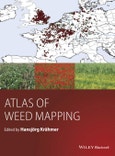Weeds are variously defined as plants growing where they are not wanted, plants that interfere with human activity. Weeds affect everyone in the world by reducing crop yield and quality, delaying or interfering with harvesting, interfering with animal feeding, reducing animal health, preventing water flow, as plant parasites, etc. It is estimated that those problems cause $ billions worth of crop losses annually and the global cost of controlling weeds also runs into many $ billions every year.
Atlas of Weed Mapping presents an introductory overview on the occurrence of the most common weeds of the world. The book notably includes:
- Description of cropping practices and explanations for the global distribution of weeds
- Invasive plant mapping
- Aquatics and wetland plants with histological plant details
- Theoretical and practical aspects of weed mapping
- Aspects on the documentation of herbicide resistance
- Biodiversity, rare weeds and the dominance of the most common weeds
Fully illustrated with more than 800 coloured figures and a number of tables, this new characterisation of anthropogenic vegetation will be interesting for readers of a great number of disciplines such as agriculture, botany, ecology, geobotany and plant community research. More than a hundred experts have contributed data to this unique compilation.
Table of Contents
Contributors, vii
Acknowledgements, ix
Introduction 1
Part I: Continental views of weed infestation maps
Hansjörg Krähmer
1 Europe 7
Hansjörg Krähmer
2 Asia 23
Hansjörg Krähmer
3 North America 47
Hansjörg Krähmer
4 South America 56
Hansjörg Krähmer
5 Africa 71
Hansjörg Krähmer
6 Australia 81
Hansjörg Krähmer
Part II: Special crop view and mapping of cotton weeds
7 Cotton cultivation 87
Garifalia Economou, Ahmet Uludag and Hansjörg Krähmer
8 Global cotton weed distribution 90
Garifalia Economou, Ahmet Uludag and Hansjörg Krähmer
9 Farming practices and weed infestation 101
Garifalia Economou, Ahmet Uludag and Hansjörg Krähmer
10 Summary of global cotton weed distribution 102
Garifalia Economou, Ahmet Uludag and Hansjörg Krähmer
Part III: Invasive weed species
11 Overview of selected problems 105
Hansjörg Krähmer
Part IV: Global zones with similar weed infestation
12 Introduction to global zones with similar weed infestation 115
Hansjörg Krähmer
13 Cereal weed belts 117
Hansjörg Krähmer
14 Maize weed belts and areas of similar weed infestation 120
Hansjörg Krähmer
15 Soybean weed zones and areas 123
Hansjörg Krähmer
16 Rice weed belts 124
Hansjörg Krähmer
Part V: General observations on all infested sites
17 Ranks and number of weed species in a defined crop 129
Hansjörg Krähmer
18 Specialization of weeds and biodiversity 130
Hansjörg Krähmer
Part VI: Answers to key questions: What makes which weed grow where and when?
19 Weeds as crop companions 135
Hansjörg Krähmer
20 Can we associate weeds with specific environmental conditions? 139
Hansjörg Krähmer
21 What makes weeds grow in monocultures, what makes them compete with the crop and with other weeds? 161
Hansjörg Krähmer
Part VII: Aesthetics, rare weeds and production objectives in agriculture
22 Rare weeds in arable crops and aesthetics: harmony or hunger? 169
Hansjörg Krähmer
Part VIII: Weeds in meadows, pastures and rangeland
23 Overview of grassland 177
Hansjörg Krähmer
Part IX: Aquatic and wetland weeds
24 Introduction 185
Hansjörg Krähmer
25 Morphological adaptation to water 192
Hansjörg Krähmer
26 Aerenchyma within the stem 194
Hansjörg Krähmer
27 Stem and vascular bundle modifications 215
Hansjörg Krähmer
28 The root 277
Hansjörg Krähmer
29 The leaf 311
Hansjörg Krähmer
30 Vegetative propagation 371
Hansjörg Krähmer
31 Aesthetics, species attractiveness and rare aquatic species 377
Hansjörg Krähmer
32 Growing conditions of aquatic plants 382
Hansjörg Krähmer
33 Dominance and noxious effects of selected aquatic and wetland species 384
Hansjörg Krähmer
34 Adaptation of terrestrial weeds to water stress: Waterlogging and temporary hypoxia 391
Hansjörg Krähmer
35 Weeds in rice 396
Hansjörg Krähmer
Part X: Which ecological rules described in textbooks will help us to understand the unevenness of weed species distribution? 36 Asymmetric competition within arable crops 401
Hansjörg Krähmer
37 Comparison of closely related species and their ability to grow as weeds in crops 404
Hansjörg Krähmer
Part XI: Factors contributing to the temporal and spatial distribution of weed resistance: a map-based analysis
38 How has Alopecurus myosuroides resistance changed over the years? 409
Martin Hess, Johannes Herrmann, Hansjörg Krähmer and Roland Beffa
39 Weeds to watch 420
Hansjörg Krähmer
Part XII: Conflict between the dominance of some weeds and the intention to preserve rare species
40 Can we shape nature into what we want it to be? 425
Hansjörg Krähmer
Part XIII: Weed data collection, analysis and presentation of results
41 Introduction to weed mapping methodology 429
Michaela Kolářová and Pavel Hamouz
42 Data collection 430
Michaela Kolářová and Pavel Hamouz
43 Approaches to the analysis of weed distribution 440
Michaela Kolářová and Pavel Hamouz
44 Presentation of weed mapping results 456
Michaela Kolářová and Pavel Hamouz
Appendix 462
Index 467








